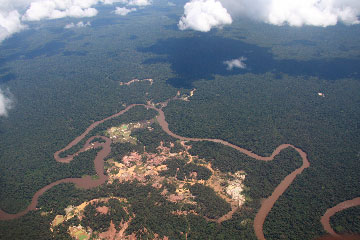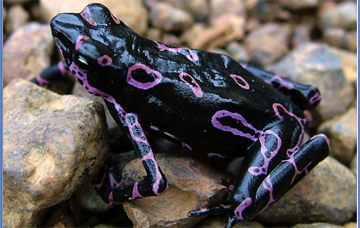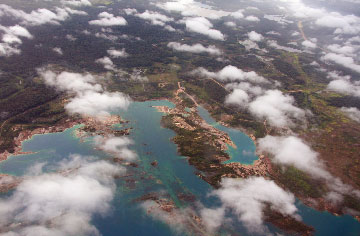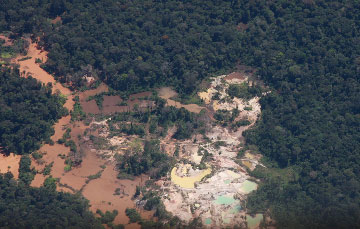Scientists call for mining ban, new protected areas in Suriname
Scientists call for mining ban, new protected areas in Suriname
mongabay.com
June 21, 2008
|
|
In a declaration set forth at their annual meeting in Paramaribo, Suriname, the largest group of tropical biologists called upon the Surinamese government to evict informal gold miners from three ecologically important areas in the South American country. Miners have been blamed for a number of environmental problems including over-hunting of wildlife, deforestation and destruction of riparian habitats, erosion, and mercury pollution in waterways.
“The bauxite mountains of northeastern Suriname – Brownsberg, Lely, Nassau — are part of an endangered and rare landscape type that represents less than 0.5% of the Suriname land surface and harbors the highest tree diversity currently known in Suriname and several specific plant groups,” stated the declaration. “The Association for Tropical Biology and Conservation [ATBC], respectfully requests the Government of the Republic of Suriname to urgently take necessary and comprehensive steps to protect the unique heritage of the Brownsberg, the Lely, and the Nassau mountains as national treasures.”
 Gold mining in Suriname |
Noting that the three areas are home to high levels of biodiversity including endemic species, ATBC asked Surinamese authorities to remove all illegal gold mining operations from Brownsberg Nature Park and to effectively enforce existing environmental regulations in the area. The scientists urged the government to ban large- and small-scale mining of gold and bauxite from the Nassau and Lely mountains and declare both zones National Protected Areas.
With more than 90 percent of its land surface forested, Suriname is part of the largest block of contiguous rainforest on the planet, but rising mineral prices are fueling pressure from miners — both small-scale miners and large-scale industrial operators — to exploit gold and bauxite deposits. Mining is presently Suriname’s largest source of foreign income but also the country’s main source of pollution and habitat degradation. Researchers say that the biggest problems are caused by small-scale miners who operate with little regard for the environment, using mercury to amalgamate gold, dredging creeks and rivers, and failing to use tailing ponds to capture mining wastes. Scientists say large-scale operators tend to be more responsive to environmental laws and face closer scrutiny from NGOs.
DECLARATION TO ESTABLISH PERMANENT PROTECTED STATUS AND PRESERVATION GUIDELINES FOR BROWNSBERG, NASSAU AND LELY MOUNTAINS IN SURINAME
WHEREAS Suriname along with Guyana, French Guiana, eastern Venezuela, and northern Brazil lies in a unique region referred to as the Guiana Shield, is one of the world’s least disturbed regions, has the lowest population density of any country in the world, and may represent one of the very few areas where extensive tracts of natural forests and other ecosystems can be conserved for future generations.
WHEREAS Suriname has been a pioneer and leader in nature conservation since the mid 20th century and has established the Central Suriname Nature Reserve, which, in 2000, was declared a United Nations World Heritage Natural site in recognition of the importance of the country’s unique habitats.

A previously unknown species of Atelopus toad discovered on the Nassau plateau in Suriname. Atelopus toads have been particularly affected by the deadly chytrid fungus. Photo © Paul Ouboter |
WHEREAS the bauxite mountains of northeastern Suriname – Brownsberg, Lely, Nassau — are part of an endangered and rare landscape type that represents less than 0.5% of the Suriname land surface and harbors the highest tree diversity currently known in Suriname and several specific plant groups (e.g., bromeliads and orchids).
WHEREAS Nassau has several species of unique fauna including two endemic fish species in upper Paramakka Creek and an endemic Atelopus frog.
WHEREAS the Nassau, Lely and Brownsberg mountains are included in the Maroni Area that was designated by 200 scientists as a high priority conservation area at the 2002 Priority Setting Workshop in Paramaribo, Suriname.
WHEREAS Brownsberg Nature Park, the only publicly accessible nature park in Suriname, contains a nearly complete complement of vertebrate species including 125 species of mammals, 374 species of birds, 83 species of reptiles, 43 species of amphibians, and 52 species of fish despite a long history of disturbance related to mining activities.
 Bauxite mining in Suriname |
WHEREAS Brownsberg Nature Park consists of 12,200 ha, including most of the Brownsberg (elev. 507 m), and has in part been leased and in part been given in concession to STINASU, the Foundation for Nature Conservation in Suriname, an organization linked to the National Forest Service, which is in charge of the conservation of forest resources.
WHEREAS Brownsberg Nature Park contains a set of unique Precolumbian archeological sites, attesting to its historical value to Amerindian peoples, and is of historical and cultural importance to the Maroon peoples living near it.
WHEREAS the Brownsberg Nature Park is the destination of more than 10,000 national and international visitors each year since 2000, including tourists, school children, and researchers, and thus represent an important recreational, educational and economic asset for Surinamese people.
WHEREAS there has been an alarming increase, since the late 1990s, in the number and size of illegal gold mining operations and hunting in and around the Brownsberg, Nassau and the Lely mountains, and which represents a serious threat to the integrity of these mountains, forests and wildlife.
 Gold mining in Suriname |
WHEREAS small- and medium-scale gold mining involves the use of mercury, a toxic metal that remains indefinitely in soils and sediment of creeks and rivers, and carries a tragic cost in loss of human health and life; causes widespread destruction of riparian habitats; increases the incidence of diseases, like malaria and HIV-AIDS; and disrupts the social and cultural fabric of local communities due to the influx of migratory miners.
WHEREAS STINASU, and other concerned parties, have voiced their concern, but lack the enforcement capacity and authority to effectively remove illegal miners from the Brownsberg Nature Park, and repeated attempts by enforcement agencies of the Government of Suriname to remove miners from within the park have failed to keep miners from resuming operations.
THEREFORE BE IT RESOLVED that the Association for Tropical Biology and Conservation, respectfully requests the Government of the Republic of Suriname to urgently take necessary and comprehensive steps to protect the unique heritage of the Brownsberg, the Lely, and the Nassau mountains as national treasures:
- establish the exact location of Brownsberg park boundaries and make these boundaries known to the public;
- remove all illegal gold mining operations from the park, effectively close and guard illegal access routes into the park from Brownsweg village, and monitor potential access routes near the park;
- enforce existing regulations already established by STINASU for care and maintenance of Brownsberg Nature Park; initiate a system for training and funding park guards as well as a system for reporting problems in the park (e.g., presence of miners and hunters); endeavor to integrate and employ the people of the villages of Brownsweg into park management and protection activities; and enforce existing park rules regarding visitor behavior (including restrictions on the collection of plants and animals);
- institute a ban on large- and small-scale mining of gold or bauxite from the Nassau and Lely mountains;
- designate the Nassau and Lely mountains as National Protected Areas and establish guidelines for use of their natural resources.
Other articles from the conference
Rainforests face array of emerging threats
(6/15/2008) Tropical forests face a number of emerging threats said a leading biologist speaking at a scientific conference in Paramaribo, Suriname.
Geology, climate links make Guiana Shield region particularly sensitive to change
(6/14/2008) Soil and climate patterns in the Guiana Shield make the region particularly sensitive to environmental change, said a scientist speaking at a biology conference in Paramaribo, Suriname.
Does logging contribute to AIDS deaths in Africa?
(6/14/2008) Logging activities in tropical Africa may pose hidden health risks to wildlife and humans according to a veterinary pathobiologist speaking at a scientific conference in Paramaribo, Suriname.
Hunting, deforestation wipe out 6 of 7 hornbill species in Borneo park
(6/14/2008) Logging, forest conversion for palm oil, and hunting have triggered a precipitous drop in key wildlife populations in Malaysia’s Lambir Hills National Park, on the island of Borneo, said a biologist speaking at a scientific conference in Paramaribo, Suriname.
New discoveries about past forest changes may help predict future ones in a changing climate
(6/12/2008) There is no better method to understand the future than to look to the past. Several new studies of the earth’s glacial history are transforming the way scientists look at tree behavior during extreme changes in climate. Scientists Remj Petit, Feng Sheng Hu, and Christopher Dick described such changes in relation to current global warming in the new issue of the journal Science. They report that already “in some parts of the world, tree species have started to shift their distributions in response to anthropogenic climatic warming”, thus raising the stakes for understanding how tree species will adapt to coming changes.
Reforestation a growing, but complicated, initiative
(6/12/2008) As the rate of deforestation continues apace — 13 million hectares per year in a global basis — several countries have begun to look at reforesting degraded areas to aid suffering biodiversity, indigenous groups, and small local economies. However most of the interest and activity surrounding reforestation is as a tool to mitigate climate change. A new program just launched by the Nature Conservancy and several local partners plans to plant a billion trees in the fragmented Atlantic Forest of Brazil. The United Nations Environmental Program has already planted over two billion trees worldwide and plans to plant five billion more. China has planted billions more. However effective reforestation is not proving as easy as simply planting trees and waiting for them to grow, in fact, sometimes it may be best to leave the whole process to nature.
Lemurs are key to health of Madagascar’s rainforests
(6/12/2008) Lemurs play a key role in the health of Madagascar’s tropical rainforests said a renowned primatologist speaking at a meeting of conservation biologists in Paramaribo, Suriname.
China’s economic growth may be helping panda habitat recovery
(6/11/2008) Rapid economic growth may be helping the recovery of key panda habitat in Wolong Nature Reserve in China, said a researcher speaking at a meeting of conservation biologists in Paramaribo, Suiname.
Guiana Shield forests help preserve biodiversity and climate
(6/9/2008) The Guiana Shield region of South America could play a significant role in efforts to fight global warming as part of a broader strategy to protect the world’s biodiversity hotspots and high biodiversty wilderness areas, said a leading conservationist speaking in Paramaribo, Suriname at a gathering of tropical biologists.
Heavily-populated Amazon was decimated by old world disease
(6/9/2008) Ecologists and archaeologists agree that when Columbus struck the Americas in 1492 everything changed, but questions persist over the kind of world Columbus and his followers would soon transform. Recently the state of the pre-Columbian Amazon has been under increasing debate among scientists across numerous fields. In a lecture given at the ATBC conference (Association of Tropical Biology and Conservation) in Paramaribo, Suriname, Dr. Francis Mayle weighed in on the debate.
Quick biological surveys are facilitating conservation efforts
(6/9/2008) Short but intense biological surveys in remote parts of the world are playing a critical role in determining conservation priorities and disseminating information to policy makers and stakeholders, said researchers speaking in a series of presentations at a scientific conference held in Paramaribo, Suriname.